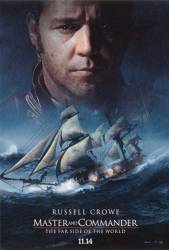Factual error: After Stephen Maturin comes back with a small portion of findings from the Galapagos Islands, he presents a stick insect to Captain Aubrey, but stick insects (Phasmids) don't exist in the Galapagos Islands. (01:41:20)

Master and Commander: The Far Side of the World (2003)
Ending / spoiler
Directed by: Peter Weir
Starring: Russell Crowe, Paul Bettany, James D'Arcy
After the British leave the Galapagos, they sail to intercept the Acheron, which was spotted by the doctor when he was looking for specimens. While the doctor and Aubrey are talking, the doctor mentions how some species of insects have evolved to look like part of their environment to avoid predators. Captain Aubrey devises a plan to disguise the Surprise as a whaling vessel and ambush the Acheron. This goes almost according to plan, and they capture the Acheron, although a number of the Surprise's crew are killed or seriously wounded. The captured Acheron, now commanded by one of the Surprise's officers, sets sail for an English port. Just as the Surprise is about to head back to the Galapagos so the doctor can find a specimen of a new bird species he discovered, the captain and the doctor realize that the French captain is still alive and aboard the Acheron with the other captives. The Surprise turns around and escorts the Acheron to port, much to the dismay to the doctor.
Joe
Capt. Jack Aubrey: This is the second time he's done this to me. There will not be a third.
Trivia: The book, from which the film is based, was actually set during the "War of 1812" between Britain and America, and in the book the Acheron is an American made vessel used by America. By contrast, in the film the Acheron is an American made ship used by the French, who are the nemesis of Britain in this film.
Join the mailing list
Separate from membership, this is to get updates about mistakes in recent releases. Addresses are not passed on to any third party, and are used solely for direct communication from this site. You can unsubscribe at any time.
Check out the mistake & trivia books, on Kindle and in paperback.




Chosen answer: The flag is a signal flag, and is probably meant to signal that the ship is a whaler or engaged in fishing operations. Such flags were part of an international code, which, with some modification, is still in use today. (The flag is similar to the modern-day "Foxtrot".)